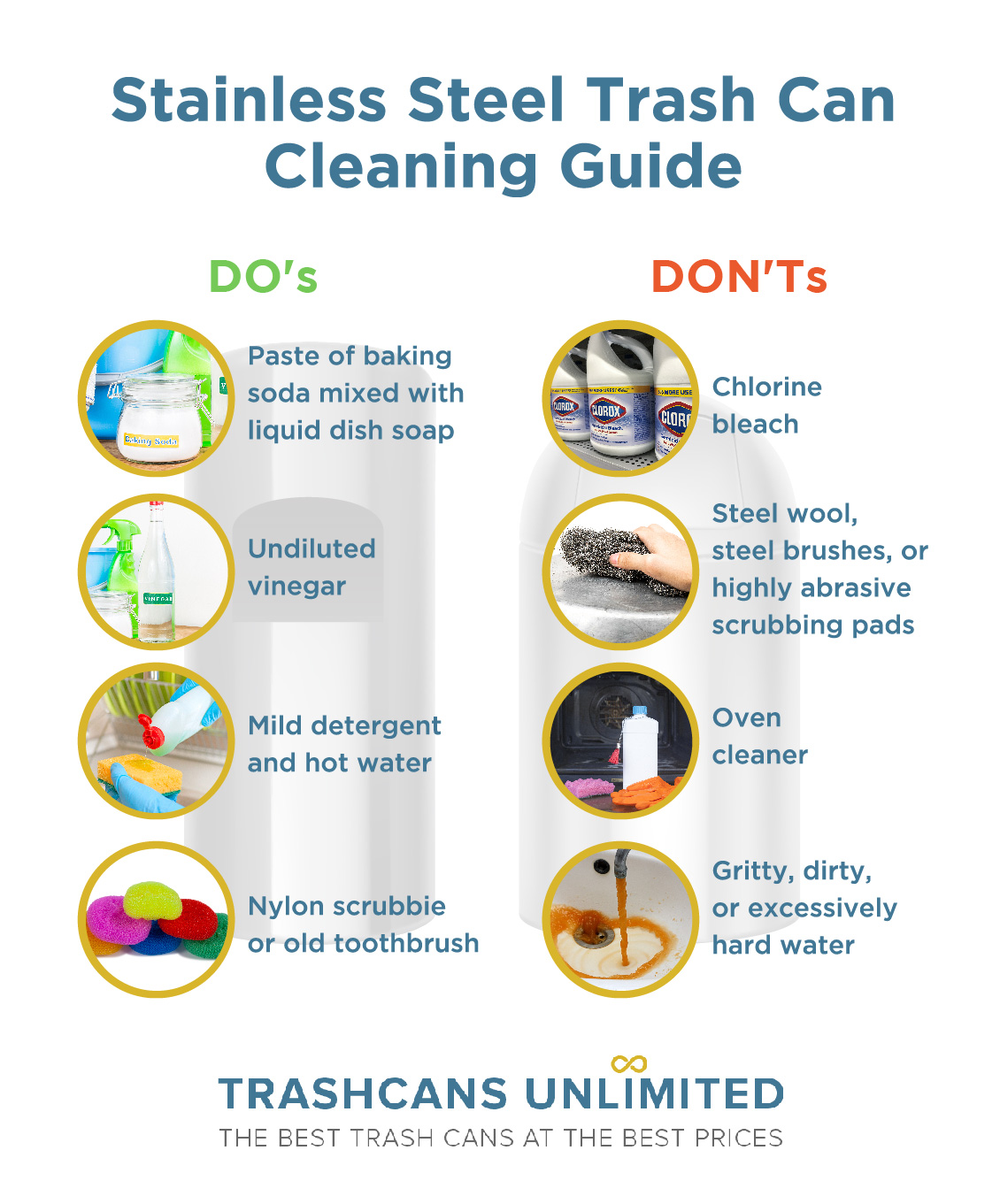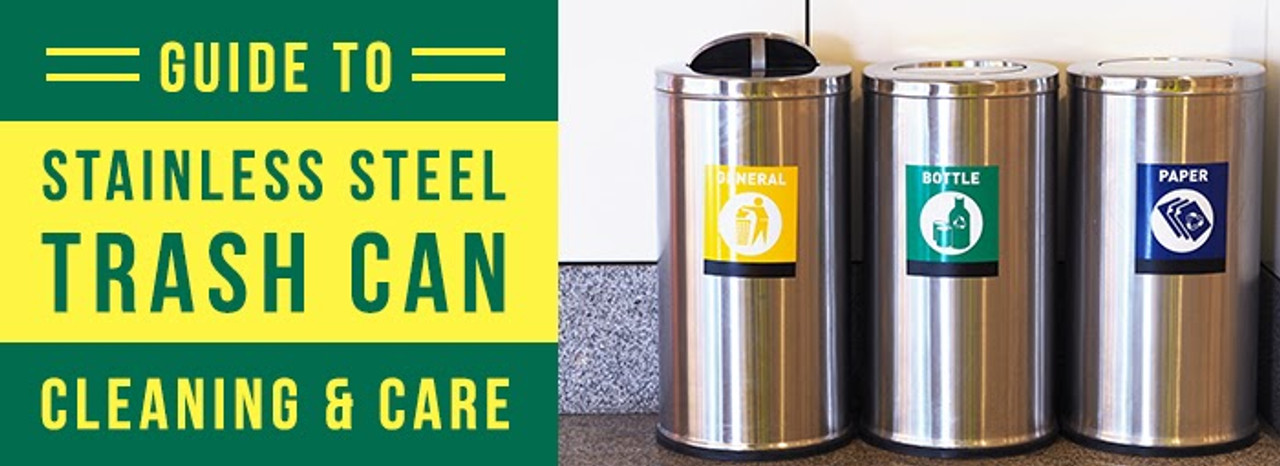Nobody likes a stinky, slimy, sticky trash can, especially one that’s supposed to be sleek and shiny. One of the reasons stainless steel is a common material for multiple uses and settings is because it resists rust and corrosion. But, if stainless steel is not properly cared for, it defeats the purpose. Luckily, cleaning and maintaining a stainless steel trash can is pretty easy.
At Trashcans Unlimited, we offer the highest quality stainless steel trash cans for homes, offices, restaurants, and more, and as such, we think it’s important to care for your trash cans. Continue reading to find out how you can clean and care for your stainless steel trash cans.
 How to Clean & Sanitize the Outside of a Stainless Steel Can
How to Clean & Sanitize the Outside of a Stainless Steel Can
One of the best habits to adopt is to wipe down the steel on a regular basis with a damp, soapy washcloth.
- Always wipe in the direction of the stainless steel “grain,” starting at the top of the unit and working your way down towards the floor.
- Rinse the washcloth with clean water and wipe again to remove any soap; then finish with a wipe of a dry terry towel.
- For heavier dirt and stains, use a nylon scrubbie, a mild detergent, and hot water. Be sure to rinse the surface and towel dry to prevent water spots.
- To remove really tough dirt and stains, make a paste of baking soda mixed with liquid dish soap and gently scrub with a nylon scrubbie or an old toothbrush. If some stains remain, use undiluted vinegar, again scrubbing gently with a soft brush. Be sure to rinse and towel dry.
- For stainless steel trash cans with scratches and discoloration, you can use stainless steel cleaners recommended to help reduce further damage, rust, and corrosion.
And remember:
- DON’T use chlorine bleach or any product containing chloride.
- DON’T use oven cleaners.
- DON’T use steel wool, steel brushes, or highly abrasive scrubbing pads—these can cause scratches or leave a residue of small particles that may rust.
- DON’T use abrasive cleansers on brushed stainless steel.
- DON’T clean a stainless steel surface unless it is cool to the touch.
- DON’T use gritty, dirty, or excessively hard water, as it can leave spots or brownish stains.
You may want to buff your units periodically with a stainless steel polish, lemon oil, or a silicone-based spray to maintain a lustrous finish. Just like before, apply the polish in the direction of the grain with a lint-free cloth; buff and dry with another lint-free cloth.
Cleaners to Use on Stainless Steel Trash Cans
There are numerous non-abrasive cleaners and polishes that are designed specifically for use on stainless steel. When in doubt, always test your cleaner on someplace hidden, like the back or sides, before moving on to the front or top. Good stainless steel cleaning options include:
- 3M professional grade
- Bar Keeper’s Friend
- Cerama Bryte
- Sprayway
- Weiman
Finally, buff out smudges or fingerprints on stainless steel trash cans as soon as you see them. You can use a glass cleaner like windex, and a dry microfiber cloth to take care of these streaks and smears.
How to Clean an Inner Plastic Can
- At least once a week: empty contents and wipe/scrub with warm soapy water until water runs clear. Don’t use steel wool, stainless steel polisher, bleach, salts or acids.
- Extra mess can be scrubbed with a scouring pad or scrub brush. You can also plan to soak the bottom of the can in warm soapy water for 15 minutes to really make sure everything is clean.
- Wipe dry with a towel and/or leave in the sun to dry.
Disinfecting
A store bought like Lysol or Clorox, or homemade disinfectant spray will work well. Making sure to find a cleaner that specifically disinfects is critical.
Deodorizing
If the can still smells bad after cleaning, deodorizing might be in order.
- For minor odor: A store bought cleaner like Lysol or Clorox, or homemade disinfectant spray will generally remove odor.
- For moderate odor: Mix 4 cups of white vinegar, ½ cup of dish soap, and water. Clean with this solution for odor-fighting power.
- For severe odor: Enzyme-based solution that is made specifically to take care of pet messes. Nature’s Miracle is a popular choice as it uses natural enzymes with no harsh chemicals.
Cleaning vs. Sanitizing vs. Disinfecting
Cleaning
Cleaning is the actual process of removing dirt, germs, viruses, and bacteria. Usually, people clean with soap and water. Cleaning might not remove or kill all of the germs, but it greatly reduces the risk.
When to clean: Clean before disinfecting because dirt and organic material can make disinfectants less effective.
Sanitizing
Sanitizing is related to public safety standards, and it refers to removing and lowering the numbers of germs to a safe level.
When to sanitize: When you need to reduce germ count, especially in the context of food preparation areas.
Disinfecting
Disinfecting is how you use chemicals to annihilate germs. It doesn’t necessarily mean cleaning, per se, but the goal of disinfection is to lower the risk of infection from all manner of nasty environmental hazards.
When to disinfect: Disinfectant to treat high-touch areas like doorknobs, light switches, and bathroom faucets, especially when a member of the household has been sick.
Tips for Maintaining a Clean Kitchen Trash Can
Want to keep things clean sustainably? Without having to overwork or overconsume? Try these tips:
- Always use a trash bag.
- Don’t throw away foods that are liquid or runny. If you do, contain them in a plastic grocery bag first. The same goes for any moldy or spoiled foods.
- Wipe down spills immediately so that they don’t have time to get sticky and gummy. A dampened microfiber cloth or paper towel is the perfect tool for this.
- Make sure your bin liner always fits snugly around the edges of your trash can. If it falls inside and you don’t realize it, you’re in for some major trash cleanup.
- Carry full trash bags to your outdoor container as soon as you can, rather than packing trash down.
- If you clean your trash can weekly or biweekly, sprinkle baking soda in the bottom to neutralize odors. Don’t use baking soda if you go longer between garbage can cleaning because it can clump up and make a bigger mess.
- Every time you change the liner, wipe with a spray of homemade cleanser of 50:50 vinegar to water and wipe it quickly with a paper towel.
The following is a list of common conditions that cause corrosion or discoloration of steel and should be avoided:
- Chloride containing cleansers – this includes bleach and any bleach containing cleaners
- Muriatic acid (hydrochloric acid) – commonly used to clean up after tile/concrete installation
- Concentrated soap residue – chemical additives will cause discoloration and some dried soaps actually look like rust
- Water with high iron content – can leave a rusty residue, especially if allowed to drip continuously
- Contact with iron materials – including steel wool, machining chips, and iron residue/dust from installation or cleaning of other steel products
- Trapped moisture between the product and another object – rubber mats, metal cans of soaps or cleaners
- Salts – contain chlorides
If your trash can is beyond repair and you need a new one, Trashcans Unlimited is here to help. We’ll make sure that you have the right knowledge and expertise to get any job done, and we’ll sell you the cans at great prices to make sure you have the right equipment.
Our stainless steel trash cans are made to last and are environmentally friendly— made from recycled heavy gauge 304 grade stainless steel, the hygienic surface has no pores to collect dirt or bacteria, and it’s fire and corrosion resistant.
If you need a new stainless steel trash can because your current one is beyond saving, here are a few suggestions:
8 Gallon Half Round Stainless Steel Trash Can
Perfect for lobbies, restrooms, reception desks, near ATMs, and entryways. The space-saver flat back design for tight spots features a convenient open top for trash disposal. It includes galvanized inner liner with handle for easy trash removal, with a rubber base to keep the unit in place and protect floors.
12 Gallon Steel Toe Tap Dog Proof Kitchen Trash Can
When your hands are full of trash, and you open the lid of your garbage can to toss it in, dirt and all of those germs come in contact with the trash can. And more than likely, that is where they'll stay, until your hands come into contact with them again. The motion sensor trash can is the solution.
This device is an automatic, 100% hands-free and foot-free, lidded waste disposal system that has a built-in Artificial Intelligence (AI) Smart-Chip and infrared technology. The lid of the trash can opens without you ever having to touch the trash can itself, ridding it of all of the bacteria that comes in contact with your hands. The lid closes tightly shortly after it opens, keeping unwanted odor to a minimum. All you have to do is move about 6 inches away from the infrared sensor near the lid.
Who and where should have the motion sensor trash can?
Hotels, dental offices, medical clinics, hospitals, laboratories, school, offices, restaurants, homes, the elderly, doctors, persons with disabilities, and everyone on earth!
13 Gallon Rectangular Swivel Lid Stainless Trash Can
Perfect for entryways, lobbies, restrooms, and waiting rooms.The skinny space-saver design for tight spots features a swivel top for easy and concealed trash disposal. It includes galvanized inner liner with handle for easy trash removal, with a rubber base to keep the unit in place and protect floors.
If these don’t catch your eye, browse even more stainless steel cans, or get in touch with us.

